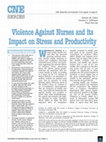Papers by Gordon Gillespie
Journal of Emergency Nursing, Nov 1, 2014
International Journal of Environmental Research and Public Health, Jun 10, 2023
Journal of Emergency Nursing, 2009
Advanced Emergency Nursing Journal, Oct 1, 2017

Background: There are debates on the risk and harm of Hookah smoking among university students. T... more Background: There are debates on the risk and harm of Hookah smoking among university students. There is a dearth of studies describing students’ experiences, causative factors and consequences of Hookah smoking among female university students. Purpose: The purpose of this study was to describe the experience of adopting Hookah smoking among female university students. Methods: A descriptive qualitative design was used for this study. A purposive sample of 14 female university students participated through face-toface interviews. Results: The study results included six main themes: Hookah smoking is cool and entertaining; attracting factors for Hookah smoking; Hookah smoking versus cigarette smoking; socio-cultural acceptance of female Hookah smoking; imminent hazardous consequences of Hookah smoking; strategies to combat Hookah smoking among female students. Conclusion: Hookah smoking has become culturally accepted by female university students. Serious attention and initiatives should be considered to enhance female internal awareness to prevent peer pressure to start Hookah smoking. This habit started at home, became accepted by parents and is now accepted in public places. Therefore, it is crucial to implement culturally competent interventions to combat Hookah smoking in private and public places. Implications for Nursing: Nurses and policy makers should address the triggering factors for increased Hookah smoking among adults. Nurses should use effective approaches for combating Hookah smoking in different community settings. Also, they should conduct and implement culturally competent preventive programs to combat Hookah smoking in different settings and among all age groups, specifically university and school students, and enhance their awareness. Additionally, it is significant to enforce legislations and policies for the prevention of Hookah smoking among adults. Keywords: Hookah, Smoking, Female, University, Students, Cigarettes.
Journal of Nursing Education and Practice, Jan 28, 2018
Sexually Transmitted Infections, Jul 1, 2013
International Journal for Quality in Health Care, Oct 1, 2021

Health & Social Care in The Community, Feb 4, 2008
Homeless adults have a higher rate of morbidity and mortality than their housed counterparts. Imp... more Homeless adults have a higher rate of morbidity and mortality than their housed counterparts. Improving the health of homeless adults is a complex problem because of the overlay of individual risk factors, social issues and lack of economic resources. Due to the increased morbidity and mortality rate in homeless adults, it is imperative to develop interventions with demonstrated efficacy that result in improved health outcomes. The purpose of this pre-post pilot study was to compare pre- and post-test scores on specific health outcomes in a group of homeless adults receiving a nurse intervention when utilising a nurse-managed clinic located in the urban core of a Midwestern city in the USA. Between September of 2004 and January 2006, 43 homeless adults completed a health survey at baseline and 2 months later that included measures of health-related quality of life (HRQOL), substance use and health resource use. There was a significant improvement on the post-test scores including substance use, perceived quality and availability of health care, and on two domains of HRQOL: mental health and vitality. This study provides evidence that a nursing intervention can result in improved health outcomes for adult homeless persons.
Rehabilitation Nursing, Sep 1, 2010
AAOHN Journal, Dec 2, 2016
Journal of Emergency Nursing, Mar 1, 2019
Work-a Journal of Prevention Assessment & Rehabilitation, Jun 9, 2015
Advanced Emergency Nursing Journal, Apr 1, 2013
Journal of Community Health Nursing, Aug 1, 2006
Journal of Adolescent Health, Nov 1, 2014
Journal of Emergency Nursing, Mar 1, 2014
Journal of Emergency Nursing, Jul 1, 2013
Currents in Pharmacy Teaching and Learning, Apr 1, 2019

PubMed, Jun 15, 2011
The purpose of this study was to examine how violence from patients and visitors is related to em... more The purpose of this study was to examine how violence from patients and visitors is related to emergency department (ED) nurses' work productivity and symptoms of post-traumatic stress disorder (PTSD). Researchers have found ED nurses experience a high prevalence of physical assaults from patients and visitors. Yet, there is little research which examines the effect violent events have on nurses' productivity, particularly their ability to provide safe and compassionate patient care. A cross-sectional design was used to gather data from ED nurses who are members of the Emergency Nurses Association in the United States. Participants were asked to complete the Impact of Events Scale-Revised and Healthcare Productivity Survey in relation to a stressful violent event. Ninety-four percent of nurses experienced at least one posttraumatic stress disorder symptom after a violent event, with 17% having scores high enough to be considered probable for PTSD. In addition, there were significant indirect relationships between stress symptoms and work productivity. Workplace violence is a significant stressor for ED nurses. Results also indicate violence has an impact on the care ED nurses provide. Interventions are needed to prevent the violence and to provide care to the ED nurse after an event.











Uploads
Papers by Gordon Gillespie